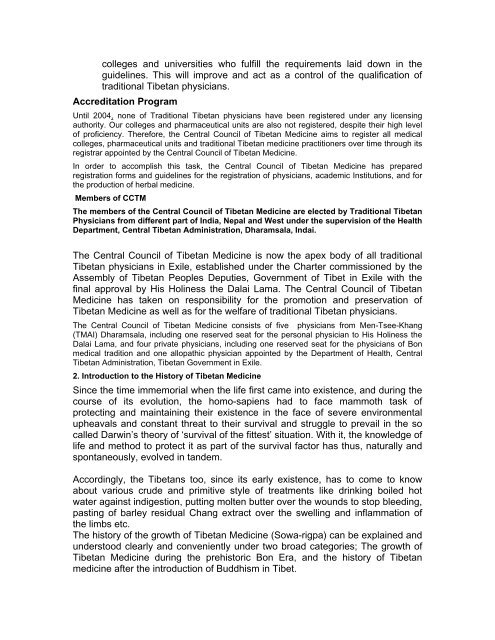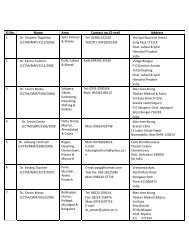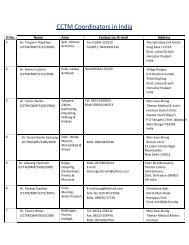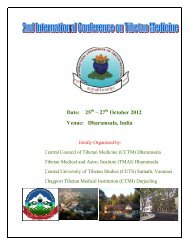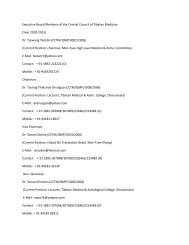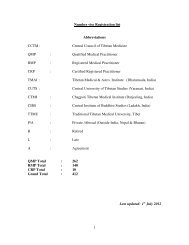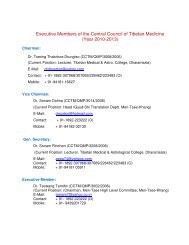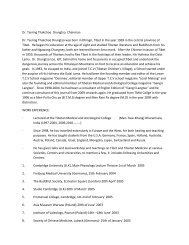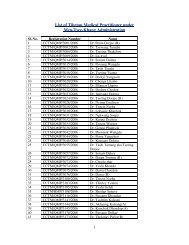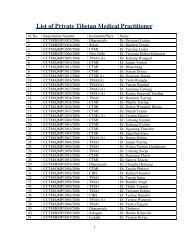1. The Central Council of Tibetan Medicine (CCTM) The Central ...
1. The Central Council of Tibetan Medicine (CCTM) The Central ...
1. The Central Council of Tibetan Medicine (CCTM) The Central ...
Create successful ePaper yourself
Turn your PDF publications into a flip-book with our unique Google optimized e-Paper software.
colleges and universities who fulfill the requirements laid down in the<br />
guidelines. This will improve and act as a control <strong>of</strong> the qualification <strong>of</strong><br />
traditional <strong>Tibetan</strong> physicians.<br />
Accreditation Program<br />
Until 2004, none <strong>of</strong> Traditional <strong>Tibetan</strong> physicians have been registered under any licensing<br />
authority. Our colleges and pharmaceutical units are also not registered, despite their high level<br />
<strong>of</strong> pr<strong>of</strong>iciency. <strong>The</strong>refore, the <strong>Central</strong> <strong>Council</strong> <strong>of</strong> <strong>Tibetan</strong> <strong>Medicine</strong> aims to register all medical<br />
colleges, pharmaceutical units and traditional <strong>Tibetan</strong> medicine practitioners over time through its<br />
registrar appointed by the <strong>Central</strong> <strong>Council</strong> <strong>of</strong> <strong>Tibetan</strong> <strong>Medicine</strong>.<br />
In order to accomplish this task, the <strong>Central</strong> <strong>Council</strong> <strong>of</strong> <strong>Tibetan</strong> <strong>Medicine</strong> has prepared<br />
registration forms and guidelines for the registration <strong>of</strong> physicians, academic Institutions, and for<br />
the production <strong>of</strong> herbal medicine.<br />
Members <strong>of</strong> <strong>CCTM</strong><br />
<strong>The</strong> members <strong>of</strong> the <strong>Central</strong> <strong>Council</strong> <strong>of</strong> <strong>Tibetan</strong> <strong>Medicine</strong> are elected by Traditional <strong>Tibetan</strong><br />
Physicians from different part <strong>of</strong> India, Nepal and West under the supervision <strong>of</strong> the Health<br />
Department, <strong>Central</strong> <strong>Tibetan</strong> Administration, Dharamsala, Indai.<br />
<strong>The</strong> <strong>Central</strong> <strong>Council</strong> <strong>of</strong> <strong>Tibetan</strong> <strong>Medicine</strong> is now the apex body <strong>of</strong> all traditional<br />
<strong>Tibetan</strong> physicians in Exile, established under the Charter commissioned by the<br />
Assembly <strong>of</strong> <strong>Tibetan</strong> Peoples Deputies, Government <strong>of</strong> Tibet in Exile with the<br />
final approval by His Holiness the Dalai Lama. <strong>The</strong> <strong>Central</strong> <strong>Council</strong> <strong>of</strong> <strong>Tibetan</strong><br />
<strong>Medicine</strong> has taken on responsibility for the promotion and preservation <strong>of</strong><br />
<strong>Tibetan</strong> <strong>Medicine</strong> as well as for the welfare <strong>of</strong> traditional <strong>Tibetan</strong> physicians.<br />
<strong>The</strong> <strong>Central</strong> <strong>Council</strong> <strong>of</strong> <strong>Tibetan</strong> <strong>Medicine</strong> consists <strong>of</strong> five physicians from Men-Tsee-Khang<br />
(TMAI) Dharamsala, including one reserved seat for the personal physician to His Holiness the<br />
Dalai Lama, and four private physicians, including one reserved seat for the physicians <strong>of</strong> Bon<br />
medical tradition and one allopathic physician appointed by the Department <strong>of</strong> Health, <strong>Central</strong><br />
<strong>Tibetan</strong> Administration, <strong>Tibetan</strong> Government in Exile.<br />
2. Introduction to the History <strong>of</strong> <strong>Tibetan</strong> <strong>Medicine</strong><br />
Since the time immemorial when the life first came into existence, and during the<br />
course <strong>of</strong> its evolution, the homo-sapiens had to face mammoth task <strong>of</strong><br />
protecting and maintaining their existence in the face <strong>of</strong> severe environmental<br />
upheavals and constant threat to their survival and struggle to prevail in the so<br />
called Darwin’s theory <strong>of</strong> ‘survival <strong>of</strong> the fittest’ situation. With it, the knowledge <strong>of</strong><br />
life and method to protect it as part <strong>of</strong> the survival factor has thus, naturally and<br />
spontaneously, evolved in tandem.<br />
Accordingly, the <strong>Tibetan</strong>s too, since its early existence, has to come to know<br />
about various crude and primitive style <strong>of</strong> treatments like drinking boiled hot<br />
water against indigestion, putting molten butter over the wounds to stop bleeding,<br />
pasting <strong>of</strong> barley residual Chang extract over the swelling and inflammation <strong>of</strong><br />
the limbs etc.<br />
<strong>The</strong> history <strong>of</strong> the growth <strong>of</strong> <strong>Tibetan</strong> <strong>Medicine</strong> (Sowa-rigpa) can be explained and<br />
understood clearly and conveniently under two broad categories; <strong>The</strong> growth <strong>of</strong><br />
<strong>Tibetan</strong> <strong>Medicine</strong> during the prehistoric Bon Era, and the history <strong>of</strong> <strong>Tibetan</strong><br />
medicine after the introduction <strong>of</strong> Buddhism in Tibet.


